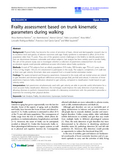Mostrar el registro sencillo del ítem
Frailty assessment based on trunk kinematic parameters during walking
| dc.creator | Martínez Ramírez, Alicia | es_ES |
| dc.creator | Martinikorena Aranburu, Ion | es_ES |
| dc.creator | Gómez Fernández, Marisol | es_ES |
| dc.creator | Lecumberri Villamediana, Pablo | es_ES |
| dc.creator | Millor Muruzábal, Nora | es_ES |
| dc.creator | Rodríguez Mañas, Leocadio | es_ES |
| dc.creator | García García, Francisco José | es_ES |
| dc.creator | Izquierdo Redín, Mikel | es_ES |
| dc.date.accessioned | 2015-09-25T06:16:03Z | |
| dc.date.available | 2015-09-25T06:16:03Z | |
| dc.date.issued | 2015 | |
| dc.identifier.issn | 1743-0003 (electronic) | |
| dc.identifier.uri | https://hdl.handle.net/2454/18265 | |
| dc.description.abstract | Background: Physical frailty has become the center of attention of basic, clinical and demographic research due to its incidence level and gravity of adverse outcomes with age. Frailty syndrome is estimated to affect 20 % of the population older than 75 years. Thus, one of the greatest current challenges in this field is to identify parameters that can discriminate between vulnerable and robust subjects. Gait analysis has been widely used to predict frailty. The aim of the present study was to investigate whether a collection of parameters extracted from the trunk acceleration signals could provide additional accurate information about frailty syndrome. Methods: A total of 718 subjects from an elderly population (319 males, 399 females; age: 75.4 ± 6.1 years, mass: 71.8 ± 12.4 kg, height: 158 ± 6 cm) volunteered to participate in this study. The subjects completed a 3-m walk test at their own gait velocity. Kinematic data were acquired from a tri-axial inertial orientation tracker. Findings: The spatio-temporal and frequency parameters measured in this study with an inertial sensor are related to gait disorders and showed significant differences among groups (frail, pre-frail and robust). A selection of those parameters improves frailty classification obtained to gait velocity, compared to classification model based on gait velocity solely. Interpretation: Gait parameters simultaneously used with gait velocity are able to provide useful information for a more accurate frailty classification. Moreover, this technique could improve the early detection of pre-frail status, allowing clinicians to perform measurements outside of a laboratory environment with the potential to prescribe a treatment for reversing their physical decline. | en |
| dc.description.sponsorship | This work was supported in part by the Spanish Department of Health and Institute Carlos III of the Government of Spain [Spanish Net on Aging and frailty; (RETICEF)], and Economy and Competitivity Department of the Government of Spain, under grants numbered RD12/043/0002, and DEP2011-24105, respectively. | en |
| dc.format.mimetype | application/pdf | en |
| dc.language.iso | eng | en |
| dc.publisher | BioMed Central | en |
| dc.relation.ispartof | Journal of Neuroengineering and Rehabilitation 2015, 12:48 | en |
| dc.rights | © 2015 Martinez Ramirez et al.; licensee BioMed Central. This is an Open Access article distributed under the terms of the Creative Commons Attribution License (http://creativecommons.org/licenses/by/4.0), which permits unrestricted use, distribution, and reproduction in any medium, provided the original work is properly credited. The Creative Commons Public Domain Dedication waiver (http://creativecommons.org/publicdomain/zero/1.0/) applies to the data made available in this article, unless otherwise stated. | en |
| dc.rights.uri | http://creativecommons.org/licenses/by/4.0/ | |
| dc.rights.uri | http://creativecommons.org/publicdomain/zero/1.0/ | |
| dc.subject | Gait analysis | en |
| dc.subject | Frailty | en |
| dc.subject | Accelerometer | en |
| dc.subject | Gyroscope | en |
| dc.subject | Inertial sensors | en |
| dc.title | Frailty assessment based on trunk kinematic parameters during walking | en |
| dc.type | info:eu-repo/semantics/article | en |
| dc.type | Artículo / Artikulua | es |
| dc.contributor.department | Matemáticas | es_ES |
| dc.contributor.department | Matematika | eu |
| dc.rights.accessRights | info:eu-repo/semantics/openAccess | en |
| dc.rights.accessRights | Acceso abierto / Sarbide irekia | es |
| dc.identifier.doi | 10.1186/s12984-015-0040-6 | |
| dc.relation.projectID | info:eu-repo/grantAgreement/MICINN//DEP2011-24105/ES/ | en |
| dc.relation.publisherversion | https://dx.doi.org/10.1186/s12984-015-0040-6 | |
| dc.type.version | info:eu-repo/semantics/publishedVersion | en |
| dc.type.version | Versión publicada / Argitaratu den bertsioa | es |
Ficheros en el ítem
Este ítem aparece en la(s) siguiente(s) colección(ones)
La licencia del ítem se describe como © 2015 Martinez Ramirez et al.; licensee BioMed Central. This is an Open Access article distributed under the terms of the
Creative Commons Attribution License (http://creativecommons.org/licenses/by/4.0), which permits unrestricted use,
distribution, and reproduction in any medium, provided the original work is properly credited. The Creative Commons Public
Domain Dedication waiver (http://creativecommons.org/publicdomain/zero/1.0/) applies to the data made available in this
article, unless otherwise stated.



